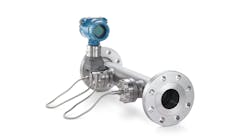This column is moderated by Béla Lipták, automation and safety consultant and editor of the Instrument and Automation Engineers' Handbook (IAEH). If you have an automation-related question for this column, write to [email protected].
Q: Venturi flowmeters are good for volumetric flow rate measurement. If we need mass flow rate, we generally multiply the volumetric reading by density. But when density changes as a function of volumetric flow rate (pressure drop across the Venturi), the measurement becomes more complicated.
Is there a way to use a Venturi to measure mass instead of volumetric flow? Also, would variation in the molecular weight of the gas play into compressor surge calculations?
Kindly help me out.
Abhishek
[email protected]
A1: Most compressors use Venturi meters on the discharge because they have a low sustained pressure loss and are accurate. Coriolis meters aren't used because when a compressor approaches surge conditions it’s rendered inaccurate; it reads high when vibrations increase.
For many compressor applications, gas purity or gas density is measured separately on the inlet, and this value is updated (after validation) to the anti-surge controls.
Venturi differential pressure, discharge pressure, discharge temperature and density inputs are brought into a PLC or other fast controller to calculate the volumetric flow, polytropic head, surge line and output to an anti-surge valve.
If the gas composition is changing, there isn’t any easy way to get around the requirement for a gas density or composition measurement.
Ralph J. McCloskey
Chief Engineer – Process Control Center of Excellence
Honeywell Process Solutions
[email protected]
A2: I'd suggest using a reference from the American Gas Association (AGA) for flow calculations of natural gas via orifice plates. It's in AGA Report No. 3, Part 2: Orifice Metering of Natural Gas and Other Related Hydrocarbon Fluids - Concentric, Square-edged Orifice Meters, Specifications and Installation Requirements.
With regards to the compressibility factor (z), it includes calculators that can be used to estimate mass flow.
Simon Pate
[email protected]
Figure 1: The key to effective surge protection is high-speed, linear, double-bypass and direct-acting valves (1- to 3-second response) and a flow controller that keep the flow within maximum and minimum limits. Violent surge can cause oscillation, flow seat damage and even flow reversal.
A3: While we're on the topic of compressor surge control, it's worth noting the emerging importance of high-pressure hydrogen. Future energy projections agree that in the long term mankind will convert its energy economy to solar-hydrogen and that the first step in this conversion process will be a switch from coal to natural gas (NG). Actually, some lobbyists are already (falsely) calling natural gas a "temporary green" fuel. But no matter which side of the climate change debate one might be on, all can agree we're leaving the fossil energy age and entering the a higher-pressure, hydrogen-based energy economy of the future. To successfully complete this conversion, we must be able to seal the emptying wells and provide all compressors with optimized surge controls.
Our NG compressor-based distribution networks consist of thousands of piping systems up to 42-in in diameter and their associated controls, often unprotected from cyber-terrorism. While these systems require sophisticated controls, they’ve been in operation for decades, and are well proven and understood. (In the fourth edition of my industrial controls handbook, I devoted a full chapter to a detailed description of these control algorithms.) Such compressor systems already operate at fairly high pressures (from 250 psig to 1,500 psig for NG). And with a transition to hydrogen, supply pressures in our interstate and international pipelines will be raised to 10,000 psig.
Hydrogen centrifugal compressors must operate at top speeds that are three times faster than natural gas compressors to achieve the same compression ratio because of the low molecular weight of hydrogen. So, coming back to your basic question, I would stick with using the Venturi on the suction side of the compressor, and combine that reading with a separate densitometer reading. I don't use Coriolis in such applications because they depend on an induced oscillation and therefore tend to read high under vibrating conditions.
Béla Lipták
[email protected]





